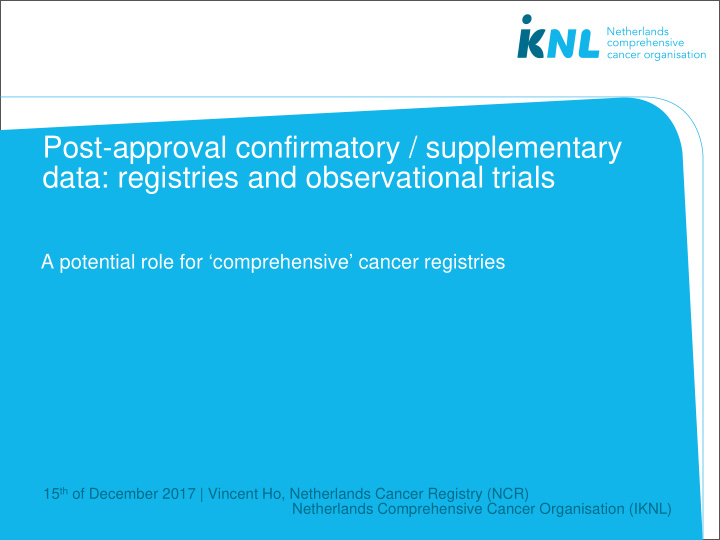



Post-approval confirmatory / supplementary data: registries and observational trials A potential role for ‘comprehensive’ cancer registries 15 th of December 2017 | Vincent Ho, Netherlands Cancer Registry (NCR) Netherlands Comprehensive Cancer Organisation (IKNL)
Disclosure (potential) conflicts of interests None Sources of conflicts of interest may include (but are not limited to): • Research funding • Fees for presentations / publications • Sponsoring
Postapproval data • General motivation - providing stakeholders information on the continued safety and effectiveness of drugs, medical devices etc. - extension beyond experimental context (controlled conditions, selected patient populations, limited time horizons) • Particularly - expedited / conditional approval allowing manufacturers to address unresolved issues (optimal dosing, long-term side effects, use in specific subgroups)
NEJM, September 2017
JNCI, 2011 - accelerated approval to 35 products for 47 new indications - clinical benefit confirmed for 26/47 (conversion to regular approval) - median time 3.9 years (range 0.8–12.6 years) for conversion - confirmatory trials not completed for 14 indications “ The slow, irregular pace of postapproval studies contrasts starkly with the short, rigid deadlines and other shortcuts used to speed marketing approval ” “The “catch 22” is that we only know the true performance of a product after approval, but the product must be safe and effective in order to be approved” (Muni, 2005)
BMJ, September 2017
Postapproval data • Data collection methods? - randomized, double-blinded, controlled trial - randomized, unblinded clinical study - observational (conditions of approval) studies - non-randomized registry study with formal follow-up and data collection (single arm trial) - informal registry study (“open enrollment”) with less stringent follow-up and data collection - meta-analyses - model/laboratory studies
Postapproval data Which methods are best for collecting and analyzing postapproval data? • Potentially, a large array of methodologies may transfer information on a product’s performance in the ‘real world’, provided that this information is understood in the proper context • No single method can meet all of the needs of stakeholders - problem remains (and is perhaps even amplified): when do we consider evidence compelling enough?
Postapproval data - practical considerations do foster preferences for some methods over others, particularly in case of rare instances: (Grahame- Smith and Aronson, 2004)
Observational trials? • Well-known caveats in methodology (although sophisticated methods have emerged) • Especially for rare conditions - low number of cases in clinical practices - representative samples (expertise across hospitals)? - need for adequate screening platforms to direct patients to the right doctor
(Clinical) registries • Existing infrastructure with ‘real-world’ focus (population-based) • Potential for flexible and adaptable data collection: retrospective and prospective data on a variety of different parameters • Standardisation of longitudinal data collection with the capability to evolve (e.g. as more is learned about a given topic) • Opportunities for linkage with other databases • Rare conditions may be captured ‘along the way’ • Issues include: - (generally) voluntary on the part of doctors and patients - data quality and completeness
A role for cancer registries? • Normally - person characteristics (date of birth, age at diagnose, date of death) - disease characteristics (topography, morphology) • Sometimes - stage of disease • Hardly ever - treatment (1st line) - genetic profile - cause of death - 2nd and 3rd line treatment • Rarely - hormone receptors (Kraywinkel, 2017) - comorbidity - recurrence, disease progression
Examples from the NCR Cancer of unknown primary (CUP): incidence
Examples from the NCR Cancer of unknown primary (CUP): first visit
Examples from the NCR Cancer of unknown primary (CUP): first treatment
Examples from the NCR Breast cancer receptors: ER, PR, HER2
Examples from the NCR Breast cancer receptors: HER2 detection method
Examples from the NCR Breast cancer receptors: relation with recurrence (Kwast et al, 2011)
Examples from the NCR • GIST: incidence
Examples from the NCR • GIST: first line targeted therapy (blue)
Examples from the NCR • GIST: first line imatinib (pink; in registry since 2014)
Examples from the NCR • GIST: additional data collection as of 2016 - immunohistochemistry CD117 DOG1 SDHB - mutations BRAF PDGF SDH
Examples from the NCR • Glioblastoma: ‘real world’ confirmation of Stupp-trial (Ho et al, 2014)
Examples from the NCR The phase 3 AZA-001 trial 1 Dutch daily practice (PHAROS MDS) 2 1.0 1.0 Difference: 9.5 months Difference: 9.6 months 0.9 Survival probability 0.8 0.75 24.5 months 16.9 months 0.7 0.6 0.5 0.5 0.4 0.3 0.25 BSC § CCR* 0.2 7.3 months 15.0 months 0.1 0.0 0.0 0 6 12 18 24 30 36 0 5 10 15 20 25 30 35 40 Months Months § BSC, best supportive care MDS, myelodysplastic syndromes; *CCR, conventional care regimens (includes 2 Dinmohamed AG et al. Leukemia . 29:2449-51 (2015) best supportive care, low-dose cytarabine and intensive chemotherapy) 1 Fenaux P et al. Lancet Oncol . 10: 223-32 (2009)
Examples from the NCR Therapeutic effectiveness of novel, expensive agents in daily practice Retrospective studies: • Azacitidine: MDS patients (2008–2011) • Ibrutinib: ibrutinib-treated CLL patients (2015–2016) • Brenduximab vendotin: brentuximab vendotin-treated HL patients (2015–2016) • Nivolumab: nivolumab-treated HL-patients (2016–2018) Prospective studies: • Pomalidomide: MM patients (2015– ; pay-for-performance) • Daratumumab: MM patients (2018– ; pay-for-performance)
‘Comprehensive’ cancer registry? • National database since 1989 - coverage estimated at 95% - > 2 million cases in database - > 100.000 cases per year • Flexible registry…
PLCRC Patient population: Colorectal carcinoma (all stages) Observational study: Interventional study: Collection of data Cohort Multiple Randomised Controlled Trial (cmRCT) Tissue Blood Clinical PROMs
(Relton et al, 2010)
Summary • Data for postapproval evaluation of agents may be hard to come by. • Most postapproval studies have yet to confirm preliminary results used to substantiate initial approval. • Cancer registries may aid in collecting impactful data on well-defined outcomes of interest in postapproval evaluation and observatonial studies.
www.iknl.nl www.linkedin.com/company/iknl twitter.com/iknl
Process PALGA NCR LBZ other databases
Recommend
More recommend